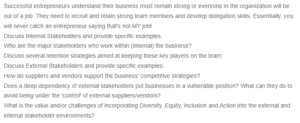Business Stakeholders
Internal stakeholders are individuals or parties that operate within the business and are directly influenced by or directly influence business activities. In most cases, they include the managers, employees, investors, and owners whose interest has been firmly vested in the business for a long time; thus, efforts made by these stakeholders are long-term and strategically positioned for the success of the business entity (Surbi, 2015). Employees are crucial to the business’s success; thus, keeping them motivated by improving the work environment and fostering teamwork and reward systems is vital to maintaining a healthy workforce (Paais & Pattiruhu, 2020). On the other hand, investors and owners can be retained in the business by continuously keeping them in the loop on business performance and meeting their investment goals—improved profit margins realized at the end of the year.
External stakeholders, on the other hand, are individuals or parties that are not part of the business but are indirectly influenced by or they indirectly influence the business. They include suppliers, competitors, creditors, customers, clients, and the government (Williams & Lumen Learning, n.d.). A robust supplier and vendor relationship with the business often renders a competitive advantage given that these two stakeholders influence how products are moved to the market after processing and how well access to high-quality raw materials at affordable prices (Michigan State University, 2019). Nevertheless, the deep dependency on external stakeholders such as suppliers and vendors can be harmful to the business. In most cases, the business can overcome this by fostering strong relationships with such stakeholders, thus eliminating the risk of one supplier or vendor dependency. While this stand, ensuring diversity, equity, and inclusivity in the business environment position the business in a strategically competitive environment against the competitors. However, this is challenged by aspects such as communication barriers and hostility from the various stakeholders unwilling to match up the diversity, equity, and inclusivity demands.
Do you need help with your assignment? Reach out to us.
References
Michigan State University. (2019, March 5). How to Use Your Supply Chain to Gain Competitive Advantage | MSU Online. Michigan State University. https://www.michiganstateuniversityonline.com/resources/supply-chain/gain-a-competitive-advantage-with-your-supply-chain/.
Paais, M., & Pattiruhu, J. R. (2020). Effect of motivation, leadership, and organizational culture on satisfaction and employee performance. The Journal of Asian Finance, Economics and Business, 7(8), 577–588.
Surbi, S. (2015, August 31). Difference Between Internal and External Stakeholders (with Comparison Chart). Key Differences. https://keydifferences.com/difference-between-internal-and-external-stakeholders.html.
Williams, L. & Lumen Learning. (n.d.). Business Stakeholders | Introduction to Business. Retrieved November 15, 2022, from https://courses.lumenlearning.com/suny-hccc-introbusiness/chapter/business-stakeholders-2/.
ORDER A PLAGIARISM-FREE PAPER HERE
We’ll write everything from scratch
Question

Business Stakeholders
Successful entrepreneurs understand their business must remain strong or everyone in the organization will be out of a job. They need to recruit and retain strong team members and develop delegation skills. Essentially, you will never catch an entrepreneur saying that’s not MY job!
Discuss Internal Stakeholders and provide specific examples:
Who are the major stakeholders who work within (internal) the business?
Discuss several retention strategies aimed at keeping these key players on the team.
Discuss External Stakeholders and provide specific examples:
How do suppliers and vendors support the business’ competitive strategies?
Does a deep dependency of external stakeholders put businesses in a vulnerable position? What can they do to avoid being under the ‘control’ of external suppliers/vendors?
What is the value and/or challenges of incorporating Diversity, Equity, Inclusion and Action into the external and internal stakeholder environments?

